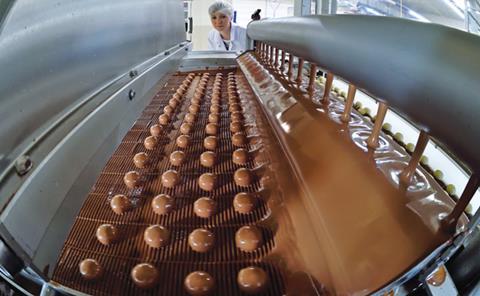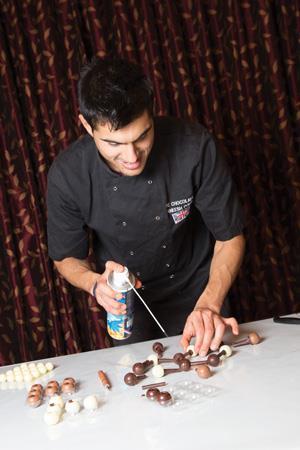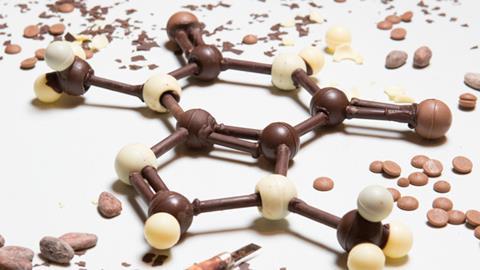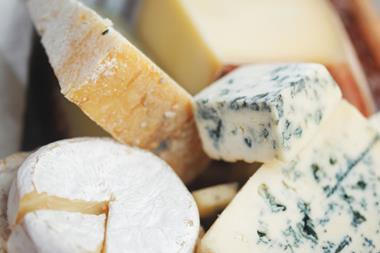Nina Notman discovers that controlling crystal structures and emulsions is the key to good chocolate
Armed with a palette knife, thermometer and marble worktop, I discovered for myself how hard an ingredient chocolate is to tame. Under the watchful eye of Bristol chocolatier Zara Narracott, I poured melted chocolate on the marble, pushed it back and forth with the flat blade of the knife while it rapidly cooled, before scraping it back into a bowl and stirring vigorously. It was all in vain; I succeeding only in producing something streaky and soft. It was not the uniform glossy chocolate we had been prepped on how to make at the start of the chocolate tempering workshop less than 30 minutes earlier.
Tempering in metallurgy refers to heating and cooling a metal, normally steel, to improve properties such as consistency, durability or hardness. The same is true for chocolate. Narracott passes me an untempered piece for tasting: it has a white coating and looks dry. Once in the mouth, it instantly crumbles rather than melts, but still tastes good. Next up is an extremely smooth and glossy-looking dark chocolate with a caramel centre. Biting into it gives a very satisfying crunch allowing the caramel to ooze out. Delicious.
Cocoa butter – the fat obtained from cocoa beans and mainly consisting of oleic, palmitic and stearic fatty acids – gives chocolate its physical structure. When tempering chocolate, it is the crystal structure of the cocoa butter that chocolatiers are manipulating. ‘Cocoa butter is a six-phase polymorphic crystal,’ explains chocolatier Richard Tango-Lowy, a physics graduate who now runs the Dancing Lion Chocolate shop in Manchester, US. The desirable crystal structure for chocolate is form V.
A taste of tempering
Tempering is required when making chocolate from its core ingredients: cocoa butter, cocoa solids, sugar, an emulsifier and flavouring. And, if you wish to retain the glossy look, it is also required every time chocolate is heated; for example, for moulding or adding different flavours. Artisan chocolatiers, including Narracott and Tango-Lowy, rarely make their own chocolate; instead, they buy in sacks of chips of high quality couverture chocolate, containing a higher percentage of cocoa butter than standard chocolate.
Prior to the workshop, Matt Hartings– who teaches a chemistry of cooking class at American University, Washington DC, US – had talked me through the basics of the tempering process. The first step is to melt the chocolate to destroy all the cocoa butter crystals that are present. ‘The chocolate is then cooled down very precisely, holding the temperature just below where the good cocoa butter crystal form is made,’ he explains. It varies from chocolate to chocolate, but generally form V crystals start to form just below 35°C, whereas undesirable form IV crystals crystallise out at around 27°C. Form VI crystals take too long to form and therefore aren’t created during the rapid tempering process, even though their higher melting point suggests they should be.

Theoretically, tempering should give you only form V crystals, but in practice some form IV seed crystals form too. ‘You then warm it up again a little, so that any bad [form IV] crystals that have formed re-melt and you’re left with just good crystals. Once that happens, then you can cool it down and pour it into moulds,’ Hartings explains. As the chocolate cools, the seed crystals present from the first step speed up the kinetics of form V crystal formation. While form V will be the dominant crystal structure for the cocoa butter triglycerides in the chocolate, a few of the lower melting point IV crystals or other crystal forms will form again as it cools.
Tempered chocolate takes several weeks to fully crystallise. ‘We typically mould the bars, allow them to crystallise in a cool environment overnight, then package them and store them in the same controlled environment for a week or two before putting them out for sale,’ explains Tango-Lowy. Filled chocolates are trickier due to the relatively short shelf life of their soft centres. ‘We typically put bonbons out for sale 3–4 days after production.’
There are many different ways to carry out the tempering process, but the one favoured by many artisan chocolatiers including Narracott and Tango-Lowy is the tabling method. The ‘table’ in this context is a cool surface such as a marble worktop or slab. Around three quarters of the melted chocolate from a bowl is poured onto the table and ‘worked’ while it cools using a palette knife or similar instrument. The cooled chocolate is then warmed a little by returning it to the bowl and stirring well with the remaining uncooled chocolate. ‘It sounds really simple and as it turns out it’s really hard to do,’ says Tango-Lowy. Hartings had also warned me before the workshop: ‘Chocolate is one of the more demanding things chemically to work with.’
At home, the easiest way to temper chocolate is to slowly add pieces of chocolate that have already been tempered to a bowl of melted chocolate and stir well until they have just melted. The tempered chocolate acts as seed crystals, feeding the formation of form V cocoa butter crystals as the chocolate cools. The proportions required are normally around a quarter solid chocolate to three quarters melted chocolate.
On an industrial scale, tempering chocolate involves extremely high-tech and expensive machinery. The Cadbury chocolate factory in Birmingham, UK, is one of the largest chocolate factories in the world. ‘In the factory we use tempering machines,’ explains Hayleigh Perks, a chocolate scientist at Cadbury. ‘The tempering machine takes the [already made] chocolate through the temperature [change] process. The chocolate melts, is cooled down and then heated back up to the desired temperature.’ The molten chocolate is poured into moulds – for Easter eggs or bars – straight from the sealed tempering machine and then immediately wrapped. The form V crystals formed in the machine then seed throughout the bar. ‘It takes three to four weeks for a chocolate bar from production to be fully crystallised,’ explains Perks.
A blooming pain
Once fully crystallised, a chocolate bar may still undergo undesired changes in structure. This is because the dominant form V cocoa butter crystals are not the most stable crystal form: form VI is. Over time, form V crystals will very slowly transform into larger form VI crystals. These larger crystals, when present on the surface of chocolate, diffuse light, giving it a greyish appearance and a lack of gloss. This is called fat bloom. ‘The dominant mode of fat bloom is the result of the form V to VI polymorphic transition that takes place with cocoa butter triglycerides,’ explains Dérick Rousseau, who studies the microstructure of chocolate at his team’s food research lab at Ryerson University in Toronto, Canada. Temperature fluctuations accelerate this process by causing smaller cocoa butter crystals to melt and be deposited onto larger ones.
Bloom is more likely in chocolates with soft centres than in solid bars. ‘You have a greater likelihood of fat bloom taking place with any filled chocolate,’ says Rousseau. The liquid fats in the fillings will migrate through the solid shell to the surface of the chocolate where they re-crystallise in an uncontrolled manner. ‘Liquid fats may also deposit onto pre-existing form V or VI crystals and feed the growth of these crystals, which will promote bloom even further.’
The main thing manufacturers can do to prevent bloom is to ensure their chocolate is as well tempered as possible, because form IV cocoa butter crystals are more susceptible to bloom than form V. ‘I can prevent some of the bloom by tempering my chocolate as optimally as possible. That means it’s the most resistant,’ explains Tango-Lowy. Some chocolatiers also add cocoa butter equivalents and additives to help hinder bloom formation.
Fantastic flavours
The size – as well as the proportion – of the form V cocoa butter crystals can also be controlled during the tempering process. On the slab in his artisan shop, Tango-Lowy tweaks the amount of working he gives his cooling chocolate with a palette knife to control crystal size. ‘If you crystallise chocolate to get very small form V crystals that are nicely arrayed, you can get a really good reflectivity off of the chocolate and make it look like glass,’ he says.
Chocolate has three times as many aromatic components as red wine
The size of the crystals also determines the amount of energy that has to be put in to break it down – and therefore how quickly the chocolate’s flavour will be released – once in the mouth. Tango-Lowy explains what happens when chocolate comprised of very small cocoa butter crystals goes into your mouth. ‘It sits there a moment and as it heats in your mouth (and then chewing starts) the crystalline structure breaks down, then the flavour will start to slowly release.’
The flavour of chocolate will then develop slowly in the mouth. ‘A lot of things have an impact on how that flavour develops,’ he says. Another important player is the organic molecules within the chocolate. ‘Chocolate has three times as many aromatic components as red wine. As a chocolatier, my job is to be able to tease those out and emphasise them when I feel like. We spend days tasting a chocolate to really understand its flavour profile and then learn how we can work with that chocolate to bring out the most character.’
Additional flavours are sometimes added to help emphasise a chocolate’s own flavour, and this can be to the chocolate itself or to the centre of filled chocolates. Flavour combinations sold by Tango-Lowy include orange liqueur, orange oil and nutmeg truffle in Axiom 60% dark chocolate, caramel with Hawaiian sea salt in Kenshi 70% dark milk chocolate, and banana maple ganache in Peruvian Piura 67% dark chocolate.
Chocolatier Aneesh Popat, a maths graduate and owner of artisan chocolate shop The Chocolatier in London, UK, is also well known for experimental flavour combinations. He claims to match flavour components on a ‘chemical level’ rather than worry about whether they sound nice or not. Citrus olive oil pralines, a 100% Madagascan chocolate bar with green grapes, and a black olive and pink peppercorn 70% chocolate bar are three of the unique delights he has created.
Slashing fat levels
Popat also produces a range of truffles called water ganaches. Conventional truffle centres contain a ganache comprised of chocolate with either cream, butter or a cheaper hydrogenated fat. The fillings of Popat’s truffles are water-based instead. This approach is attributed to the French chemist and molecular gastronomist Hervé This, and made popular by celebrity chef Heston Blumenthal. ‘The beauty is because water is flavourless all you taste is chocolate, because there’s no cream or butter masking the flavour,’ explains Popat.

His ganache is an emulsion of chocolate suspended in water and even though there is no cream present the truffle appears creamy in the mouth. ‘It’s almost a trick. [The emulsion] is actually quite granular, but your palate’s not smart enough to sense that level of particle size and it detects it as creaminess,’ he explains. Popat also uses unique flavour combinations – such chilli and lime, tomato and haricot bean, and coconut allspice – in the fillings of these chocolates. As an added bonus these water ganaches contain 40–50% fewer calories than standard truffles.
While Popat’s fillings are lower in fat that the norm, the chocolate coating them and contained within the emulsion is not: it is standard chocolate. Ian Norton and his chemical engineering group at the University of Birmingham, UK, have been working on making chocolate itself lower in fat. Again an emulsion is being used, but here the water droplets are suspended in cocoa butter that is then used to make chocolate.
If you added water to the ingredients used to make chocolate, the sugar would hydrate and a terrible mess would form, explains Norton. But in his approach the water and sugar and are physically separated. ‘You make a water-in-cocoa-butter emulsion and then crystallise the cocoa butter. The cocoa butter crystals [will naturally] go onto the water–oil interface forming an eggshell-type structure,’ he says. When added to the rest of the chocolate making ingredients, ‘you have a barrier between the sugar and the water’. These droplets of water coated with cocoa butter are approximately 1µm in diameter.
Norton’s chocolate making process also eliminates the need to temper chocolate, as the modified cocoa butter is already in form V when the chocolate is made. ‘You can put the crystals straight in in the form you want and get away from having to temper at all,’ says Norton.
10–15% of the cocoa butter can be replaced with water without people noticing it, he adds. ‘Because you’ve got the right form of cocoa butter on the interface it melts in the mouth and the low level of water mixes with saliva’ and therefore is undetectable. Norton’s team has also been able to put different flavours inside the droplets including sugar water, sweeteners and fruit juice. ‘Once you build these structures, you can put anything in them,’ he says. ‘You could even put molecules that have bioactivity in there if you wanted to.’
This low-fat chocolate manufacturing process developed by Norton’s team is very similar to the process used to make margarine industrially. ‘We have been working closely with a company that, as far as I know, is in the process of commercialising it,’ Norton says. He is unable to disclose the company he has collaborated with, but many manufacturers have spoken out about a desire to produce low-fat chocolate bars.
Cadbury, for example, have previously announced an interest in producing a low-calorie Dairy Milk bar. ‘The Holy Grail for us would be a chocolate bar that has no or low fat and no sugar, but we haven’t reached that point yet,’ says Tony Bilsborough, a Cadbury spokesperson. ‘If we can find that magical recipe, identical in taste and texture to Cadbury Dairy Milk, we’ll be trying it with the public. Until that point we’ll be sticking with what we know and love.’
It isn’t just the taste and texture that is of concern for Cadbury though. The use of the term ‘chocolate’ is tightly regulated. The legislation varies in different locations around the world, but manufacturers must have a certain proportion of cocoa solids and cocoa butter in their product to call it chocolate. ‘We want to produce chocolate and not something like chocolate,’ says Perks. These rules also normally limit which additional ingredients can be added to chocolate to reduce fat bloom, while still being able to call it chocolate.
Form V cocoa butter crystals are the key to good chocolate making – whether it is carried out the traditional way on a stone slab, in the home, in a factory in a tempering machine, or in the lab in machinery designed for manufacturing margarine. ‘Chocolatiers are doing some really well-controlled chemistry,’ agrees Hartings. ‘They have more control over their process than a lot of us [chemists] do in our labs.’
Nina Notman is a science writer based in Salisbury, UK













No comments yet